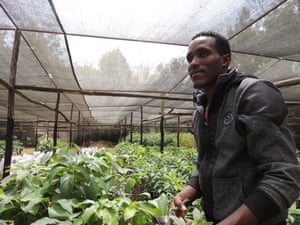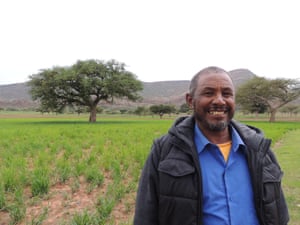
Returned migrant Kahsay Gebretsadik in the nursery at Gergera, Ethiopia. He is one of many young landless men and women working at the small business. Photograph: Cathy Watson
Kahsay Gebretsadik was arrested at 5am in Saudi Arabia. As an illegal immigrant with no papers he knew this was the end of his stay.
After 15 days in prison, police placed him on a plane to Addis Ababa, one of 160,000 Ethiopian migrants expelled from Saudi Arabia in recent years. A perilous trek out of Ethiopia followed by two years of back-breaking work for a Bengali building contractor had come to nothing.
Gebretsadik, now 30, is one of nine children. The family has just 0.6 acres of land in the semi-arid state of Tigray, where only 400-800mm of rain falls a year. The land offered no work and Gebretsadik failed to find a job after school – even though his country’s economy had been growing by double digits for a decade – so when he heard “interesting stories” from friends, he opted to migrate.
As is most often the case in Africa, he headed to a nearby region. “I walked through Djibouti and then to Yemen,” he told me. “Because our journey was illegal, we were guided by brokers. We walked day and night for more than a month – 170 males and females. Sometimes the brokers fought. It was not good for me.”
Now home again in Gergera in far north Ethiopia, Gebretsadik is hopeful that land restoration will allow him to stay there. He has joined a group of 15 that includes four other returnees, and they are running a business producing tree seedlings and fodder grass for farmers and to support regreening in their local authority.
“When the kebele – our village government – called for people who have no land, I became a member of this nursery,” he says. He hopes to be given fields recaptured from a gulley 100m wide and 13km long. Short bursts of rain, loss of trees and climate change, have carved the gulley through arable land. “If you work hard in farming, you get good returns,” he says.
Out migration has long been a survival strategy in the Ethiopian highlands where deforestation and erosion are thought to date back 3,000 years. Berhe Hishe, 48, a farmer who leads 350 households in Gergera, migrated himself at one point to survive. “Because of the severity of the drought, I went to the city of Asmara. When we were away, we saw so many challenges. What we know is that if we work hard at home, it will be better than leaving.”
With the help of funding from Irish Aid, Ethiopian researchers from World Agroforestry Centre (Icraf) are guiding terrace design, construction of a rainwater tank on the summit, and which trees and crops to grow. “Restoration activities were already going on, but the donor and the Tigray Bureau of Agriculture and Natural Resources requested us to provide robust science-based approaches,” says Dr Kiros Hagdu who heads Icraf in Ethiopia. “They wanted it to be more productive and sustainable.”
The ultimate aim on this hillside and across the landscape is to create cultivable land for landless people. “Before the mountains were bare,” says Hishe. “When there was heavy rain, the flood and big stones damaged houses. Now we are more stable. I’m so happy about these activities. I am hopeful our youth will get more land.”
He says improved seed and measures such as manuring, planting of fodder grass and trees, and moisture conservation structures have improved the life of his family. “Our land is small. We survive because of increased productivity. I used to get two quintals (100kg) from my 0.25 ha. I now get seven to 10. Hagdu says the water table has risen from 50 to 8m.”
“It’s the government’s idea,” explains Tsuruy, a local priest. “We give 50 x 50m of hillside to emerging farmers. Our young people need to farm.” Conceding that some might still prefer to leave, he says, “There are both types. Some youth do not want farming and migrate to the Middle East. But there are also youth who work on family land or rent land from widows. Many youth are also buying water pumps for irrigation.”
But the question remains: can restoration really create new land and productive lives for youth? Elsewhere in the region, Gebremichael Gidey (known as Abahawi), a community leader in the community of Abrha We Atsbha, is emphatic that it can. “Ninety percent of our youth are here. Compared to nearby villages, the main difference is that ours has become full of water. Because of that they are earning a lot of money from vegetables, livestock fattening and dairy.”
In 2012 the UN recognised the achievements of this village and awarded it the Equator prize: “Abrha We Atsbha has reclaimed over 224,000 hectares of land,” reads the citation. “Tree planting [has] resulted in improved soil quality, higher crop yields, greater biomass production, groundwater functioning, and flood prevention.”
“We worked day and night for the whole community to do two things,” says Abahawi. “Protect the landscape from any free grazing by cattle and treat the whole catchment with trees. We held on to the water and improved water flow and underground water recharge.”
Today forest, helped to regrow on the mountain, protects ponds that hold rain water that percolates to farms. A municipality called Wukro is even laying a 30km pipeline to extract water from Abreha We Atsibha – a community that the UN described as “once on the brink of resettlement due to desertification, soil degradation and lack of water”.
Communities do turn around. Across the world, drylands are the leading source of environmental refugees. Although Ethiopia’s restoration movement may need more scale, the country’s accomplishments give global hope for populations forced to move on by worn-down land.
In Abreha We Atsibha, a tall tree called Faidherbia albida grows amid crops. Grass is lush. Asked about migration, two men cutting grass for stall-fed cows say: “No one leaves this place any more.”Read more here


No comments:
Post a Comment